- Home
- Jeffery Deaver
The Final Twist Page 2
The Final Twist Read online
Page 2
But how could he tell where the assault was coming from? In a crouch he moved to where he thought the coal bin was. It would at least provide some cover. He tried to listen but all he could hear was a tinnitus-like ringing in his ears.
After five desperate minutes he was aware of a faint glow coalescing at the far end of the cellar. Light from the kitchen above.
So his vision wasn’t gone completely. He’d been temporarily blinded by the brilliance of the explosion. Finally he could make out the beam of his tac light. It was ten feet away. He collected it and shone the bright light throughout the basement and into the room on the other side of the hidden door.
No attackers.
He holstered his weapon and snapped his fingers beside each ear. His hearing was returning too.
Then he assessed.
What had just happened?
If the bomber had wanted an intruder dead, that could’ve easily been arranged. Shaw shone his light on the frame of the hidden door and found the smoking device, gray metal. It was a large flash-bang—designed with combustible materials that, when detonated, emitted blinding light and a stunning sound but didn’t fling deadly projectiles; its purpose was to serve as a warning.
He looked carefully to see why he’d missed it. Well, interesting. The device was a projectile. It had been launched from a shelf near the hidden door, rigged to explode after a half second or so. This is what had hit him in the chest. The trigger would be a motion or proximity detector. Shaw had never heard of a mechanism like this.
He carefully scanned the room for more traps. He found none.
Who had set it? His father and his colleagues had likely made the secret room, but they probably would not have left the grenade. Ashton Shaw never worked with explosives. Possessing them without a license was illegal, and, for all his father’s serious devotion to survivalism and distrust of authority, he didn’t break the law.
Never give the authorities that kind of control over you.
Then Shaw confirmed his father could not have created the trap. When he examined the device more closely under the searing white beam, he noted that it was military-issue and bore a date stamp of last year.
Shaw flicked on an overhead light and tucked his flashlight away. He saw a battered utility table in the center of the twenty-by-twenty space, an old wooden chair, shelves that were largely bare but held some papers and clothes. Other stacks of documents sat against the wall. A large olive-drab duffel bag was in the corner.
On the table were scores of papers.
Was this it? The hidden treasure that others—his father among them—had died for?
He walked around the table, so he was facing the doorway to the secret room, and bent forward to find out.
3
Colter Shaw was here because of a discovery he’d made on his family’s Compound in the soaring peaks of eastern California.
There, on high and austere Echo Ridge, where his father had died, Shaw had found a letter the man had written and hidden years ago.
A letter that would change Shaw’s life.
Ashton began the missive by saying that over his years as a professor and amateur historian and political scientist, he’d come to distrust the power of large corporations, institutions, politicians and wealthy individuals “who thrive in the netherworld between legality and illegality, democracy and dictatorship.” He formed a circle of friends and fellow professors to take on and expose their corruption.
The company that they first set their sights on was BlackBridge Corporate Solutions, a firm known for its work in the shadowy field of corporate espionage. The outfit was behind many questionable practices, but the one that Ashton and his colleagues found the most reprehensible was their “Urban Improvement Plan,” or “UIP.” On the surface it appeared to help developers locate real estate. But BlackBridge took the brokerage role one step further. Working with local gangs, BlackBridge operatives flooded targeted neighborhoods with free and cheap opioids, fentanyl and meth. Addiction soared. As the neighborhoods became unlivable, developers swooped in to buy them up for next to nothing.
This same tactic won results for political clients: PACs, lobbyists and candidates themselves. The infestation of illegal drugs would cause a shift in population as residents moved out, affecting congressional districting. The UIP was, in effect, gerrymandering by narcotics.
BlackBridge’s schemes became personal for Ashton Shaw when a friend and former student of his—then a San Francisco city councilman—began looking into the UIP operation. Todd Zaleski and his wife were found murdered, a close-range gunshot for each of them. It appeared to be a robbery gone bad, but Ashton knew better.
He and his colleagues looked for evidence against the company, hoping to build a case for authorities. Nearly all BlackBridge workers refused to talk to them but he managed to learn of an employee who felt the UIP had crossed a line. A researcher for BlackBridge, Amos Gahl, found some evidence and smuggled it out of the company. The man hid what he’d stolen somewhere in the San Francisco area. But before he could contact Ashton or the authorities, he too was dead—the victim of a suspicious car crash.
Ashton had written in his letter: It became my obsession to find what Gahl had hidden.
Then BlackBridge learned of Ashton and those who shared his obsession. Several died in mysterious accidents, and the others dropped out of the mission, fearful for their lives. Soon, Ashton was alone in his quest to bring down the company that had killed his student and so many others in the City by the Bay—and, likely, untold other cities.
Then on a cold October night, Colter Shaw, sixteen years old, discovered his father’s body in desolate Echo Ridge.
Since then, he’d become well aware of the shady figures he was up against:
Ian Helms, founder and CEO of BlackBridge. Now in his mid-fifties and movie-star handsome, he had had some national defense or intelligence jobs in the past and had worked in politics and lobbying.
Ebbitt Droon, a “facilitator” for the company, which is to say a hitman, was wiry with rat-like features. After several personal run-ins with the man, including one that featured a Molotov cocktail hurled in Shaw’s direction, he was sure that Droon was a certifiable sadist.
Irena Braxton, BlackBridge operative in charge of stopping Ashton—and now stopping his son. Of her Ashton had written:
She may look like somebody’s grandmother but oh, my, no. She’s the picture of ruthlessness and will do what needs to be done.
She was an external relations supervisor, a euphemistic job description if ever there was one.
Ashton had concluded his letter with this:
Now, we get around to you.
You’ve clearly followed the breadcrumbs I’ve left leading you to Echo Ridge and now know the whole story.
I can hardly in good conscience ask you to take on this perilous job. No reasonable person would. But if you are so inclined, I will say that in picking up where my search has ended, you’ll be fighting to secure justice for those who have perished or had their lives upended by BlackBridge and its clients, and you’ll be guaranteeing that thousands in the future will not suffer similar fates.
The map included here indicates the locations in the city that might contain—or lead to—the evidence Gahl hid. After leaving this letter and accompanying documents, I will be returning to San Francisco and I hope I will have found more leads. They can be found at 618 Alvarez Street in San Francisco.
Finally, let me say this:
Never assume you’re safe.
A.S.
4
This was Colter Shaw’s mission. To check out each of the locations on his father’s map—there were eighteen of them—and find the evidence Amos Gahl had hidden.
As he now looked over the documents in the secret room of the safe house’s basement, he realized they had nothing to do with BlackBridge. They had to do with engineering projec
ts and shipping. Some in English, some in Russian or perhaps another language using Cyrillic characters. Other printouts were in Spanish, a language that he could speak, and they related to shipping and transportation too. There were a number in Chinese as well.
Someone was using the secret room as a base of operations. One of the original members of his father’s circle? Or, like Shaw, second generation? A man or a woman? Young? Middle-aged? Some of these materials were dated recently. He turned to the duffel bag on the floor and—after an examination for a tripwire—unzipped it.
Inside was the answer to the question of gender. The clothing was a man’s, of larger-than-average physique. T-shirts, work shirts, cargo pants, jeans, sweaters, wool socks, baseball caps, gloves, casual jackets. Everything was black, charcoal gray or dark green.
Then he saw in the shadows against the back wall another stack of papers. Ah, here was his father’s material. It was Ashton from whom Shaw had learned the art of calligraphy, and the man wrote in a script even more elegant—and smaller—than Shaw’s.
His heart beat just a bit faster, seeing these.
Shaw carried the stack upstairs and set the papers on the rickety kitchen table. He sat down in an equally uncertain chair and began to read. There were more details about the UIP, and references to other schemes the company engaged in: dodgy earthquake inspections of high-rises (some located on the San Andreas Fault, no less), government contract kickbacks, land-use and zoning ploys, stock market manipulations, money laundering.
There was a clipping about the death of a California state assemblyman, with two question marks beside the victim’s picture. The man had died in a car crash on the way to meet with a state attorney general. The resulting fire had destroyed his auto and boxes of records he had with him. The crash was curious but no criminal investigation was begun.
He found as well articles about Todd Zaleski, his father’s former student turned city councilman whom Ashton believed was murdered by BlackBridge.
Everything he found hinted at the company’s guilt. But this wasn’t evidence—at least not enough for a prosecutor. Shaw had some experience on the topic of criminal law. After college he’d worked in a law firm, while deciding whether to take the LSATs and apply to law school. He’d been particularly inspired to study the subject by one Professor Sharphorn at the University of Michigan and thought he might take up the profession. In the end, his restless nature put the kibosh on a desk job, but an interest in the law stayed with him and he often read up on the subject; it was also helpful in his reward-seeking job.
No, nothing his father had found would interest the D.A.’s office.
Shaw then found a note, presumably from a colleague of Amos Gahl, intended for Ashton. It was a small sheet of paper folded many times. This no doubt meant it would have been left in a dead-drop, a spy technique of hiding communiqués under park benches or cracks in walls, avoiding the risk of electronic intercepts.
Amos is dead. It’s in a BlackBridge courier bag. Don’t know where he hid it. This is my last note. Too dangerous. Good luck.
So “it”—the evidence—was in a company bag hidden in one of the eighteen locations Ashton had identified as a likely spot. An arduous task, but there was no way around it. He’d have to start with the first and keep going until he found the courier bag—or give up after none of them panned out.
But he soon learned he wouldn’t have to investigate eighteen locations. In fact, he didn’t need to check out any.
He discovered in the stack a map identical to the one he’d found in Echo Ridge—well, identical except for one difference. All eighteen of the locations were crossed off with bold red Xs.
After leaving the map at the Compound, Ashton, as he’d written, had returned here and searched the sites himself, eliminating them all.
Shaw sighed. This meant that the evidence that would destroy BlackBridge could be squirreled away anywhere within the entire San Francisco Bay Area, which had to embrace thousands of square miles.
Maybe Ashton had discovered other possible sites. Shaw returned to the material to look for more clues, but his search was interrupted at that moment.
From Alvarez Street, out in front of the safe house, a woman called out. “Please!” she cried. “Somebody! Help me!”
5
Shaw looked out the bay window to see two people struggling in front of the chain-link gate that opened onto a scruffy lot containing the remnants of a building that had been partly burned years ago.
The dark-haired woman was in her thirties, he guessed. Dressed in faded jeans, a T-shirt, a scuffed dark blue leather jacket, running shoes. A white earbud cord dangled. She was looking around frantically as a squat man, dressed in a dusty, tattered combat jacket and baggy pants, gripped her forearm. The man was white and had a grimy look about him. Homeless, Shaw guessed, and, like many, possibly schizophrenic or a borderline personality. The man held a box cutter and was pulling the woman toward the gate. He seemed strong, which wasn’t unusual; life on the street was physically arduous; to get by you needed to practice a version of survivalism. Even from this distance, Shaw could see veins rising high on the man’s hands and forehead.
Through the front door and down the concrete steps fast, then approaching the two of them. Her face desperate, eyes wide, the woman looked toward him. “Please! He’s hurting me!”
The attacker’s eyes cut to Shaw. At first there was a mad defiance on the man’s face, which struck Shaw as impish. With his short height and broad chest, he might be cast as a creature in a fantasy or mythological movie. His hands indeed looked strong.
“Oh, yeah, skinny boy, you want some of this? Fuck off.”
Shaw kept coming.
The man waved the weapon dramatically. “You think I’m kidding?”
Shaw kept coming.
You’d think the guy wouldn’t be in a carnal mood any longer, given the third-party presence. But he gripped the woman just as insistently as a moment ago, as if she were a home-run ball he’d caught in the stadium and wasn’t going to give up to another fan. Without loosening his hold he stepped closer toward Shaw.
Who kept coming.
“Jesus! You deaf, asshole?”
In the Shaw family’s Sierra Nevada enclave, where he had taught his children survival skills, Ashton had spent much time on firearms, those confounding inventions that are both blessings and curses. One of his father’s rules was borrowed—straight from Shooting Practices 101.
Never draw a gun unless you intend to use it.
Shaw drew the Glock and pointed it at the attacker’s head.
The man froze.
Shaw was taking his father’s rule to heart, as he usually did with the man’s lengthy list of don’ts. He believed, however, that the definition of use was open to interpretation. His was somewhat broader than Ashton’s. In this case it meant not pulling the trigger but instead scaring the shit out of someone.
It was working.
“Oh . . . No, man . . . no, don’t! Please! I didn’t mean anything. I was just standing here. Asked her for some money. I ain’t ate in a week. Then she starts coming on to me.”
Shaw didn’t say anything. He wasn’t someone who negotiated or bantered. He kept the gun steady as he gazed coolly at the puckish face, which was encircled with damp, swept-back hair in a style that, Shaw believed, mercifully ceased to exist around 1975.
After a brief moment, the attacker released the woman. She stepped away, leaning against a segment of chain-link fence, breathing hard. Eyes were wide in her stricken face.
The building must have burned five years ago but, with the weighty moisture in the air, you could still detect burnt wood.
The man retracted the blade on the box cutter and started to put it away.
“No. Drop it.”
“I—”
“Drop. It.”
The gray tool clattered on
to the gravelly sidewalk.
“Out of here now.”
The man held up both his hands and backed away. Then he paused. He cocked his head and, with narrowed eyes and a hint of hope in his face, he asked, “Any chance you can spare a twenty?”
Shaw grimaced. The man ambled up the street.
Shaw holstered the gun and scanned the area. Only one other person was on the street—a bearded man in a thigh-length black coat and dark slacks, a stocking cap and an Oakland A’s backpack. He wasn’t nearby and was facing away. If he’d seen the incident, he had no interest in the participants or what had happened. The man stepped into an independent coffee shop. San Francisco, with its Italian roots, had many of these.
“My God,” the woman whispered. “Thank you!” She was a little shorter than Shaw’s six feet even, but not much, with an athletic build, toned legs and thighs under her tight-fitting distressed jeans. She had slim hips and lengthy arms. The veins were prominent in the backs of her hands too, just like her attacker’s. Her brown hair was loose. She wore no makeup on her face, which seemed weather-toughened. A scar started near her temple and disappeared into her hairline.
“I don’t know what to say. Are you, umm, police?” She glanced toward the weapon on his right hip and then perused him. She was wary.
With his short blond hair, muscular build and taciturn manner, Colter Shaw could easily be mistaken for law enforcement, a fed or a detective running complex homicides—the stuff of anti-terror cases. Today, she’d think, he was undercover, as he’d ridden here on the Yamaha in his biker gear: the jacket, navy-blue shirt under a black sweater to conceal his weapon, blue jeans and black Nocona boots.
“Kind of a private eye.”
“I’m Tricia,” she said.
He didn’t give his, either real or a cover.

 A Maiden's Grave
A Maiden's Grave Trouble in Mind: The Collected Stories - 3
Trouble in Mind: The Collected Stories - 3 The October List
The October List The Deliveryman
The Deliveryman Garden of Beasts
Garden of Beasts Triple Threat
Triple Threat The Broken Window
The Broken Window The Steel Kiss
The Steel Kiss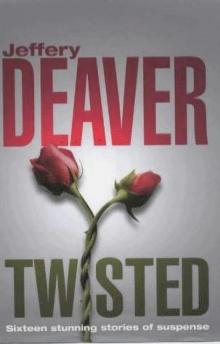 Twisted: The Collected Stories - 1
Twisted: The Collected Stories - 1 Solitude Creek
Solitude Creek Edge
Edge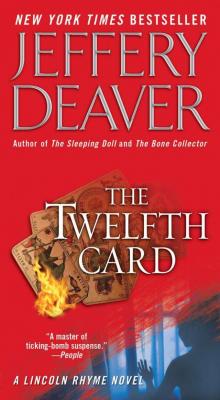 The Twelfth Card
The Twelfth Card The Bone Collector
The Bone Collector The Stone Monkey
The Stone Monkey The Sleeping Doll
The Sleeping Doll The Vanished Man
The Vanished Man The Kill Room
The Kill Room The Burial Hour
The Burial Hour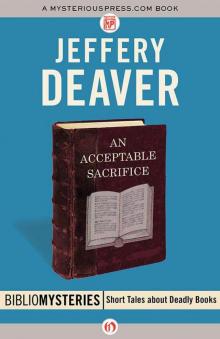 An Acceptable Sacrifice
An Acceptable Sacrifice The Coffin Dancer
The Coffin Dancer The Lesson of Her Death
The Lesson of Her Death The Empty Chair
The Empty Chair The Burning Wire
The Burning Wire Watchlist
Watchlist Captivated
Captivated The Cold Moon
The Cold Moon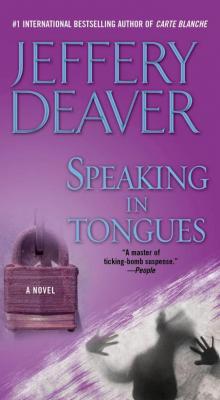 Speaking in Tongues
Speaking in Tongues Buried (Hush collection)
Buried (Hush collection) A Textbook Case
A Textbook Case The Victims' Club
The Victims' Club Nothing Good Happens After Midnight: A Suspense Magazine Anthology
Nothing Good Happens After Midnight: A Suspense Magazine Anthology The Bodies Left Behind
The Bodies Left Behind Turning Point
Turning Point Hard News
Hard News The Blue Nowhere
The Blue Nowhere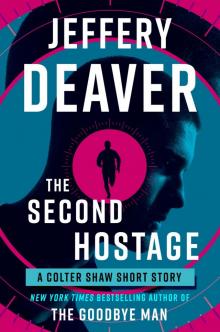 The Second Hostage
The Second Hostage The Never Game
The Never Game The Devil's Teardrop
The Devil's Teardrop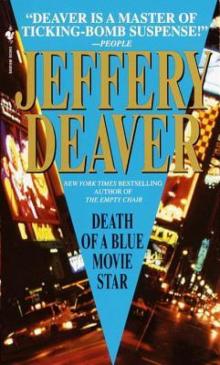 Death of a Blue Movie Star
Death of a Blue Movie Star The Skin Collector
The Skin Collector The Final Twist
The Final Twist Surprise Ending
Surprise Ending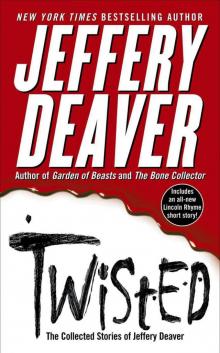 Twisted: The Collected Stories
Twisted: The Collected Stories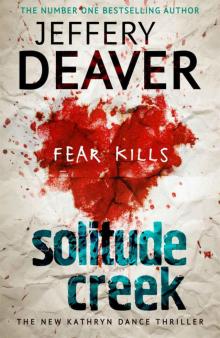 Solitude Creek: Kathryn Dance Book 4
Solitude Creek: Kathryn Dance Book 4 Twisted: The Collected Short Stories of Jeffery Deaver
Twisted: The Collected Short Stories of Jeffery Deaver Rhymes With Prey
Rhymes With Prey Shallow Graves
Shallow Graves Bloody River Blues
Bloody River Blues Trouble in Mind: The Collected Stories, Volume 3
Trouble in Mind: The Collected Stories, Volume 3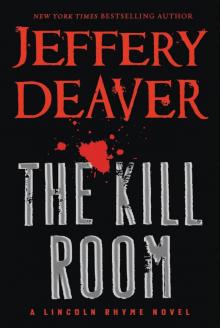 Lincoln Rhyme 10 - The Kill Room
Lincoln Rhyme 10 - The Kill Room The Cutting Edge
The Cutting Edge Where the Evidence Lies
Where the Evidence Lies Hell's Kitchen
Hell's Kitchen Twisted
Twisted The Goodbye Man
The Goodbye Man The burning wire lr-9
The burning wire lr-9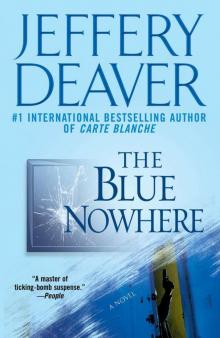 The Blue Nowhere: A Novel
The Blue Nowhere: A Novel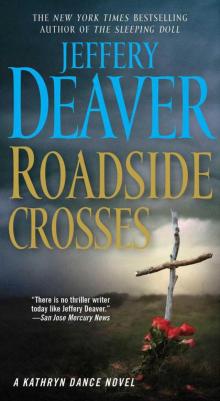 Roadside Crosses: A Kathryn Dance Novel
Roadside Crosses: A Kathryn Dance Novel The Debriefing
The Debriefing More Twisted: Collected Stories, Vol. II
More Twisted: Collected Stories, Vol. II The Kill Room lr-10
The Kill Room lr-10 A Dish Served Cold
A Dish Served Cold Bloody River Blues: A Location Scout Mystery
Bloody River Blues: A Location Scout Mystery The Bodies Left Behind: A Novel
The Bodies Left Behind: A Novel Where the Evidence Lies (A Mulholland / Strand Magazine Short)
Where the Evidence Lies (A Mulholland / Strand Magazine Short) A Textbook Case (lincoln rhyme)
A Textbook Case (lincoln rhyme) Copycat
Copycat The Chopin Manuscript: A Serial Thriller
The Chopin Manuscript: A Serial Thriller Carte Blanche
Carte Blanche The Sequel
The Sequel